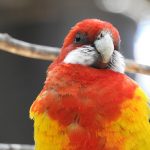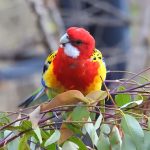EASTERN ROSELLA
The Eastern Rosella: Jewels of the Australian Canopy
Imagine a sunlit morning in the Australian bush. Among the muted greens and browns of eucalypt leaves, a flash of brilliance catches your eye. There, perched on a slender branch, is the Eastern Rosella. This medium-sized parrot, measuring around 30 to 35 centimetres, is a living kaleidoscope:
- Head, Neck, and Breast: Vivid scarlet red, as if dipped in a pot of paint.
- Back and Wings: A tapestry of black feathers edged with gold and emerald, shimmering in the dappled light.
- Tail: A graceful sweep of deep blue, accented by fine black barring.
- Cheeks: Soft white patches bordered by delicate sky blue.
Females are slightly less vibrant, their colours muted, blending more readily with the foliage—a subtle adaptation for nesting duties.
Habitat: The Eastern Rosella’s Domain
Eastern Rosellas make their homes across a broad swathe of eastern and south-eastern Australia. Picture their habitats:
- Open Woodlands: The gentle rustle of leaves, shafts of sunlight filtering through tall gums.
- Eucalypt Forests: The sharp, clean scent of eucalyptus fills the air.
- Grasslands and Farmlands: The low hum of insects and the distant call of livestock.
- Urban Gardens: The laughter of children and the aroma of freshly cut grass.
Their adaptability allows them to thrive from rural paddocks to city parks, where they flit among ornamental trees and garden beds.
Behaviour and Social Life
Eastern Rosellas are both social and spirited. In the cool of early morning, you might hear their calls—clear, ringing whistles interspersed with bursts of chattering. Their voices carry a sense of joy and urgency, echoing across the landscape.
- Flocking: Often seen in small groups or pairs, occasionally joining larger gatherings at food-rich sites.
- Foraging: With agile feet and strong, curved beaks, they search for seeds, fruits, flowers, and nectar. The crack of a seed shell and the flutter of wings are common sounds as they feed both in the canopy and on the ground.
- Urban Visitors: In suburban gardens, they may sample cultivated fruits, their bright colours a welcome sight among backyard trees.
Life Cycle: Nurturing the Next Generation
The breeding season stretches from September to January, coinciding with the Australian spring and summer. The Eastern Rosella’s approach to nesting is both practical and endearing:
- Nesting: They seek out hollows in mature trees—cool, sheltered spaces where the female lays 4 to 6 eggs.
- Incubation: The eggs are incubated for around three weeks, during which time the female is attended by her mate.
- Raising Chicks: Both parents take turns feeding and protecting the chicks. The nestling’s soft, downy feathers gradually give way to the dazzling hues of adulthood.
The gentle, rhythmic sounds from within the nest—a blend of soft cheeping and rustling—speak of new life and hope.
Conservation: Coexisting with Humanity
Currently listed as a species of Least Concern by the International Union for Conservation of Nature (IUCN), the Eastern Rosella is, for now, secure. Yet, their ongoing survival is intertwined with our choices:
- Threats: Habitat loss, predation by introduced species such as cats and foxes, and illegal trapping for the pet trade.
- Conservation Actions: Preserving old-growth trees with natural hollows, fostering wildlife-friendly gardens, and supporting responsible pet ownership.
By appreciating these birds in their wild homes rather than in cages, we help ensure the future of one of Australia’s most striking avian treasures.
Sensory Snapshot: Encounter with an Eastern Rosella
Close your eyes and imagine:
- The scent of eucalyptus on a gentle breeze.
- The bright flash of colour as a rosella lands nearby.
- The soft crunch of grass beneath your feet as you watch.
- The clear, flute-like whistle echoing through the morning air.
Such moments remind us of the beauty and complexity of Australian wildlife—and the importance of protecting it for generations to come.
| Scientific Name | Platycercus eximius |
|---|---|
| Length | 30–35 cm |
| Conservation Status | Least Concern (IUCN) |
| Main Threats | Habitat loss, predation, illegal trade |
Let us cherish and protect the Eastern Rosella, so that future mornings in Australia might always begin with the flash of their colours and the music of their calls.














